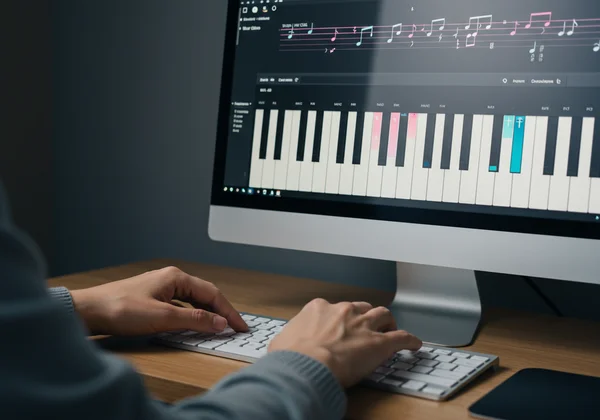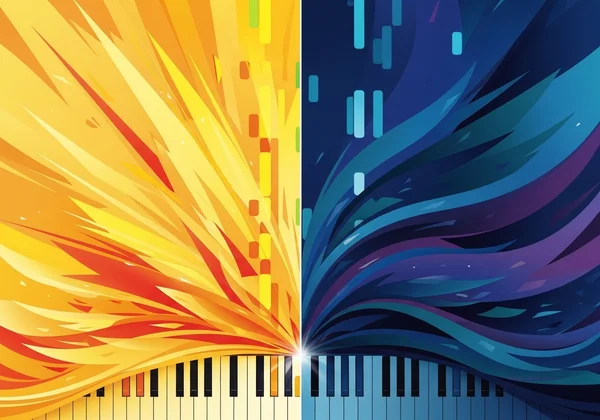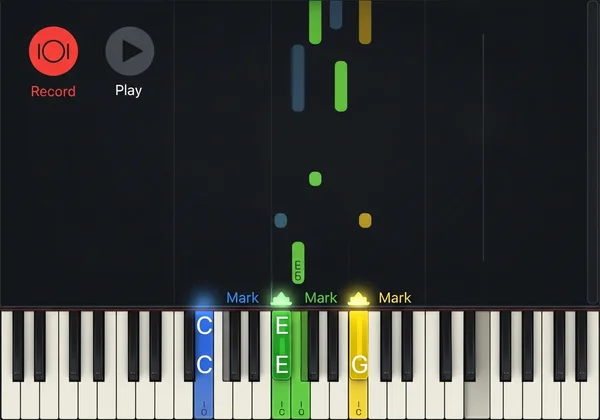Unlock Piano Chords: First Steps on Your Online Piano Keyboard
Have you been playing single notes on the piano and feel ready to make your music sound fuller and more expressive? You're ready to unlock the magic of piano chords. This guide is designed for beginners, showing you how simple it is to understand and play your first chords. How can I play piano on my computer? It's easier than you think, especially with a user-friendly online piano keyboard. We'll walk you through the first steps to add rich harmony to your melodies using our fantastic free online piano.
Chords are the foundation of almost every song you love, from simple pop tunes to complex classical pieces. Learning them is a huge leap forward in your musical journey. It's the moment you go from just playing a melody to truly making music. This tutorial will demystify chords, making them accessible and fun to learn right from your web browser. No downloads, no fees—just pure musical discovery.

Understanding Piano Chords: What Are They?
At its core, a piano chord is simply a group of three or more notes played at the same time. While a single note is a single point of sound, a chord is a full, rich soundscape. Think of it like painting: single notes are like individual colors, but chords are like mixing those colors to create a beautiful, cohesive background. They provide the emotional context for a melody, telling the listener whether the music is happy, sad, dramatic, or peaceful.
Learning chords might sound intimidating, but it’s a skill anyone can develop. With a virtual piano, you have the perfect tool to see and hear how these notes work together. You can experiment without pressure, discovering the sounds that create powerful music and give your playing a professional feel.
More Than Just Single Notes: The Power of Harmony
Why are chords so important? The answer lies in the power of harmony. Harmony is what happens when different notes sound good together, creating a pleasing and complete musical idea. When you play a chord, you're not just playing notes; you're creating an emotional atmosphere. This is what makes a song feel complete and satisfying to the ear.
Imagine your favorite song without the background instruments—just the singing. It would feel empty. Chords are like that band playing behind the singer. They provide the support, depth, and character that transform a simple tune into a full-fledged song. By learning chords, you gain the ability to create this depth yourself.
Building Blocks: How Chords Are Formed (Triads Explained)
The most basic and common type of chord is called a triad, which consists of three notes. Don’t let the term scare you; it’s a simple concept. A triad is built using a root note, a third, and a fifth. Think of the root note as the foundation of your chord. The other two notes are stacked on top of it, creating the chord's unique sound.
To understand how chords are formed, let's use the C Major scale as an example (all the white keys starting from C). The notes are C, D, E, F, G, A, B. To build a C Major triad, you start with the root note (C), skip the next note (D), play the third note (E), skip the next note (F), and play the fifth note (G). So, the C Major chord is C-E-G. It's that simple! You can start playing it right now on our piano keyboard online.

Getting Started with Basic Chords for Beginners
As a beginner, you don't need to learn hundreds of chords at once. In fact, you can play thousands of songs by mastering just a few basic chords for beginners. The most important distinction to learn first is between major and minor chords. These two types of chords form the emotional backbone of Western music.
Major chords generally sound bright, happy, and uplifting. They are used in cheerful anthems, pop hits, and celebratory music. Minor chords, on the other hand, tend to sound more somber, sad, or thoughtful. They are perfect for creating a sense of drama, introspection, or melancholy. Learning to play both will give you a full palette of emotions to work with in your music.
Mastering Major Chords: Your First Happy Sounds
Let's start with the happiest of them all: the C Major chord. As we discussed, it’s made of the notes C, E, and G. Go ahead and find these three keys on our online piano. Notice how they are all white keys, making them easy to spot. Press them all down at the same time using your computer keyboard or by clicking them with your mouse.
Hear that bright, positive sound? That’s the signature of a major chord. This is the first chord most piano students learn, and for good reason. Once you are comfortable with C Major, you can try G Major (G-B-D) and F Major (F-A-C). Mastering major chords is your first big step toward playing songs that sound familiar and fun.
Exploring Minor Chords: Adding Depth and Emotion
Now, let's explore the other side of the emotional spectrum. Minor chords add a layer of depth and sophistication to your playing. The easiest minor chord to start with is A Minor, because, like C Major, it only uses white keys: A, C, and E. Find these three keys and play them together.
Can you hear the difference? The sound is more pensive and moody compared to C Major. This is the power of a minor chord. Exploring minor chords opens up a new world of musical expression. After mastering A Minor, you can try E Minor (E-G-B) and D Minor (D-F-A). You'll be amazed at how these simple three-note chords can convey such powerful feelings.

Practice & Play: Online Piano Chords Exercises
Theory is great, but music comes to life when you play. The best way to get comfortable with chords is through practice. With our interactive tool, you can start your online piano chords exercises immediately. You don’t need anything other than the device you’re on right now.
The goal is to build muscle memory in your fingers and train your ear to recognize the different sounds. Start by playing each chord one by one. Say the name of the chord out loud as you play it: "C Major," "A Minor." This helps connect the name, the physical shape on the keyboard, and the sound in your mind. This is a crucial part of any effective online piano lessons.
Your First Chord Progression: Simple Songs Made Easy
Once you're comfortable playing individual chords, it's time to string them together into a chord progression. A chord progression is just a series of chords played in a sequence. Amazingly, thousands of popular songs use the exact same four chords. Let's learn one of the most famous progressions right now.
This is your first chord progression: C Major - G Major - A Minor - F Major.
- Play the C Major chord (C-E-G) and hold it for four counts.
- Switch to the G Major chord (G-B-D) and hold for four counts.
- Move to the A Minor chord (A-C-E) for four counts.
- Finally, play the F Major chord (F-A-C) for four counts.
Repeat this sequence over and over. Does it sound familiar? You've heard it in countless pop songs! You are now playing real music.
Utilizing Our Virtual Piano's Mark & Record Features for Chords
To make learning even easier, our online piano has powerful built-in features. When learning a new chord progression, utilizing our virtual piano's features can accelerate your progress. Use the "Mark" function to highlight the keys of each chord in your progression. For example, you can mark C, E, and G in one color, then G, B, and D in another. This visual guide helps you find the right notes quickly.
Next, use the "Record Notes" feature to capture your playing. Play your C-G-Am-F progression and then press "Play" to listen back. This is an incredible way to check your timing and ensure your chord changes are smooth. It's like having a friendly tutor who can play your music back to you, helping you improve with every session.

Start Harmonizing: Your Journey with Online Piano Chords
Congratulations! You've taken your first major step into the world of piano chords. You've learned that chords are simple groups of notes that create harmony, that major and minor chords create different emotions, and that you can play thousands of songs with just a few basic progressions. Most importantly, you know that you don't need an expensive instrument to start—your musical journey can begin right now.
The path to becoming a proficient piano player is built on these foundational skills. Keep practicing these basic chords and progressions. Experiment with different rhythms and see how it changes the feel. Your confidence will grow with every chord you master.
Ready to put your knowledge into practice? Head over to our interactive music experience and start playing. Use the Mark and Record features to master your first songs. The world of music is at your fingertips.
Frequently Asked Questions About Learning Piano Chords Online
How can I play piano chords on my computer with our virtual piano?
It's incredibly simple. Our online piano maps the piano keys to your computer keyboard. You can play single notes or press multiple keys simultaneously to form chords. You can also use your mouse or touchscreen to click on the keys. Just visit our homepage, and the interactive piano is ready to go—no installation required.
Can I truly learn piano chords online without a physical piano?
Absolutely. An online piano is a perfect tool for beginners to learn the fundamentals of music theory, including chords and scales. It helps you understand note relationships and build finger dexterity without the cost and space commitment of a real piano. It’s an ideal way to see if you have a passion for piano before making a big investment.
What are the basic notes I need to know before learning chords on an online piano keyboard?
You just need to know the names of the white keys: C, D, E, F, G, A, B. Our online piano keyboard has a feature to display the note names directly on the keys, making it easy to find them. Once you can identify these seven notes, you have everything you need to start building your first major and minor chords.
Is our virtual piano safe and effective for learning chords?
Yes, it is completely safe and highly effective. Our platform is free, requires no registration or downloads, and runs directly in your browser. We are dedicated to providing a trustworthy and educational tool. The integrated features like note display, metronome, and recording are specifically designed to make learning chords and songs an effective and fun experience for everyone. Why not practice chords now?